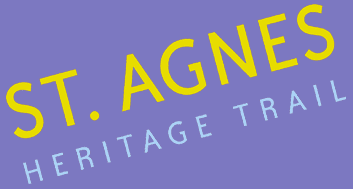
Walk 6 - Mithian
Leaving St Agnes by car from Peterville (heading to Perranporth on the B3285) you will soon come to the very small hamlet of Barkla Shop. It is situated on the two sides of a valley and is notorious for its road layout including a very sharp, left-hand bend. The surname Barkla is often encountered in these parts and there used to be two "shops", a blacksmith and a carpenter, side by side, near the thatched cottage at the bottom of the dip. The buildings were demolished to widen the road.
The Mithian turning is a little further up the hill on your right. Known as Mithian Lane, this road takes you to the heart of the village and as the "square" comes into view you will appreciate why the place has delighted artists and photographers over the years. It lays claim to be the second oldest village in Cornwall and is typical of many Cornish communities. Most of the buildings are very old and their traditional appearance helps them blend with nature and justify the statement that the village is picturesque.
The Village Hall
 On your right as you enter the village, you will see a row of three white cottages with thatched roofs. The
lower of the cottages used to house the Mithian post office. Immediately past this row of thatched cottages is
the Village Hall. Built in 1893 with the help of John Passmore Edwards of Blackwater (see Walk 10) it originally
served as a reading room or literary institute for the men of the village. The usage rules were gradually
adapted to reflect the wishes of the users providing relaxation for the men of the village and respite from the
women-folk who were not allowed access. The front porch was not part of the original building and was
added circa 1910 G. These buildings can be looked at in more detail towards the end of your walk.
On your right as you enter the village, you will see a row of three white cottages with thatched roofs. The
lower of the cottages used to house the Mithian post office. Immediately past this row of thatched cottages is
the Village Hall. Built in 1893 with the help of John Passmore Edwards of Blackwater (see Walk 10) it originally
served as a reading room or literary institute for the men of the village. The usage rules were gradually
adapted to reflect the wishes of the users providing relaxation for the men of the village and respite from the
women-folk who were not allowed access. The front porch was not part of the original building and was
added circa 1910 G. These buildings can be looked at in more detail towards the end of your walk.
Miners Arms
 In the centre of the village on your left you will see the Miners Arms public house A, this is the starting point
of the mapped walk. Formerly the Miners Inn, it was a part of Mithian Manor and is undoubtedly a very old
building. There are a number of mysteries surrounding it, not least its precise age. Many books state that it was
built in 1577 but it may well
be older considering its
historical and physical link
with the Manor House
across the road. It has been
supposed that the building
was used extensively for
smuggling and that the
tunnel that runs under the
road and re-emerges in the
Old Manor House was for
this purpose. Smuggling
was prevalent for a number
of centuries and the inn
was conveniently placed to
store the merchandise from
the prying eyes of the
Revenue Men.
In the centre of the village on your left you will see the Miners Arms public house A, this is the starting point
of the mapped walk. Formerly the Miners Inn, it was a part of Mithian Manor and is undoubtedly a very old
building. There are a number of mysteries surrounding it, not least its precise age. Many books state that it was
built in 1577 but it may well
be older considering its
historical and physical link
with the Manor House
across the road. It has been
supposed that the building
was used extensively for
smuggling and that the
tunnel that runs under the
road and re-emerges in the
Old Manor House was for
this purpose. Smuggling
was prevalent for a number
of centuries and the inn
was conveniently placed to
store the merchandise from
the prying eyes of the
Revenue Men.
 Walk 1 - St.Agnes Village Trail
Walk 1 - St.Agnes Village Trail Walk 2 - St Agnes Beacon
Walk 2 - St Agnes Beacon Walk 3 - Porthtowan, Banns Vale, Mount Hawke and Chapel Porth
Walk 3 - Porthtowan, Banns Vale, Mount Hawke and Chapel Porth Walk 4 - Wheal Rose, The Poldice Plateway and Mawla
Walk 4 - Wheal Rose, The Poldice Plateway and Mawla Walk 5 - Mount Hawke
Walk 5 - Mount Hawke Walk 6 - Mithian
Walk 6 - Mithian Walk 7 - Wheal Coates, Chapel Porth, Wheal Lawrence Valley and Goonvrea
Walk 7 - Wheal Coates, Chapel Porth, Wheal Lawrence Valley and Goonvrea Walk 8 - Water Lane, Wheal Butson and Jericho Valley
Walk 8 - Water Lane, Wheal Butson and Jericho Valley Walk 9 - Jericho Valley and Cross Coombe
Walk 9 - Jericho Valley and Cross Coombe Walk 10 - Blackwater
Walk 10 - Blackwater
